Effect of Perfluoroalkyl Endgroups on the Interactions of Tri-Block Copolymers with Monofluorinated F-DPPC Monolayers
Abstract
:1. Introduction
2. Materials and Methods
2.1. Materials
2.1.1. Lipids and Lipid Probes
2.1.2. Block Copolymers
2.1.3. Other Chemicals
2.2. Methods
2.2.1. Pressure-Area Isotherms
2.2.2. Time-Dependent Polymer Adsorption
2.2.3. Epifluorescence Microscopy
3. Results and Discussion
3.1. Surface Behavior of Pure Polymers and Pure F-DPPC at the Air/Water Interface
3.2. Time-Dependent Adsorption of Polymers to Preformed Lipid Monolayers
3.3. Compression Isotherms
3.4. Epifluorescence Microscopy
4. Conclusions
Supplementary Materials
Acknowledgments
Author Contributions
Conflicts of Interest
References
- Carvalho, M.F.; Oliveira, R.S. Natural production of fluorinated compounds and biotechnological prospects of the fluorinase enzyme. Crit. Rev. Biotechnol. 2017, 37, 880–897. [Google Scholar] [CrossRef] [PubMed]
- Sturtevant, J.M.; Ho, C.; Reimann, A. Thermotropic behavior of some fluorodimyristoylphosphatidylcholines. Proc. Natl. Acad. Sci. USA 1979, 76, 2239–2243. [Google Scholar] [CrossRef] [PubMed]
- Hirsh, D.J.; Lazaro, N.; Wright, L.R.; Boggs, J.M.; Mcintosh, T.J.; Schaefer, J. A New Monofluorinated Phosphatidylcholine Forms Interdigitated Bilayers. Biophys. J. 1998, 75, 1858–1868. [Google Scholar] [CrossRef]
- Toimil, P.; Daviña, R.; Prieto, G.; Sarmiento, F. The Influence of Calcium Ions and the Interdigitated Bilayer on the Colloidal Stability of DPPC and F-DPPC Liposomes. J. Colloid Sci. Biotechnol. 2014, 3, 194–200. [Google Scholar] [CrossRef]
- Smith, E.; Wang, W.; Dea, P.K. Effects of cholesterol on phospholipid membranes: Inhibition of the interdigitated gel phase of F-DPPC and F-DPPC/DPPC. Chem. Phys. Lipids 2012, 165, 151–159. [Google Scholar] [CrossRef] [PubMed]
- Toimil, P.; Daviña, R.; Sabín, J.; Prieto, G.; Sarmiento, F. Influence of temperature on the colloidal stability of the F-DPPC and DPPC liposomes induced by lanthanum ions. J. Colloid Interface Sci. 2012, 367, 193–198. [Google Scholar] [CrossRef] [PubMed]
- Mahrhauser, D.-S.; Reznicek, G.; Gehrig, S.; Geyer, A.; Ogris, M.; Kieweler, R.; Valenta, C. Simultaneous determination of active component and vehicle penetration from F-DPPC liposomes into porcine skin layers. Eur. J. Pharm. Biopharm. 2015, 97, 90–95. [Google Scholar] [CrossRef] [PubMed]
- Smith, E.; Smith, C.; Tanksley, B.; Dea, P.K. Effects of cis- and trans-unsaturated lipids on an interdigitated membrane. Biophys. Chem. 2014, 190–191, 1–7. [Google Scholar] [CrossRef] [PubMed]
- Smith, E.A.; Dea, P.K. Influence of the interdigitated gel phase in mixtures of ether-linked and monofluorinated ester-linked phospholipids. Chem. Phys. Lipids 2012, 165, 818–825. [Google Scholar] [CrossRef] [PubMed]
- Smith, E.; van Gorkum, C.M.; Dea, P.K. Properties of phosphatidylcholine in the presence of its monofluorinated analogue. Biophys. Chem. 2010, 147, 20–27. [Google Scholar] [CrossRef] [PubMed]
- Smith, E.; Dea, P.K. The interdigitated gel phase in mixtures of cationic and zwitterionic phospholipids. Biophys. Chem. 2015, 196, 86–91. [Google Scholar] [CrossRef] [PubMed]
- Sanii, B.; Szmodis, A.W.; Bricarello, D.; Oliver, A.E.; Parikh, A.N. Frustrated phase transformations in supported, interdigitating lipid bilayers. J. Phys. Chem. B 2010, 114, 215–219. [Google Scholar] [CrossRef] [PubMed]
- Toimil, P.; Prieto, G.; Miñones, J.; Sarmiento, F. A comparative study of F-DPPC/DPPC mixed monolayers. Influence of subphase temperature on F-DPPC and DPPC monolayers. Phys. Chem. Chem. Phys. 2010, 12, 13323–13332. [Google Scholar] [CrossRef] [PubMed]
- Shah, S.W.H. Investigations of the Potential of Synthetic Phospholipids as Membrane Mimics: Interactions with Amphiphilic and Polyphilic Block Copolymers. Ph.D. Thesis, Martin Luther University Halle-Wittenberg, Halle, Germany, 2016. [Google Scholar]
- Liu, G.; Dupont, J.; Dou, H.; Njikang, G.; Hu, J. Morphologies of Micelles of ABC Linear and Miktostar Triblock Copolymers. Polym. Prepr. 2010, 51, 1–6. [Google Scholar]
- Mai, Y.; Eisenberg, A. Self-assembly of block copolymers. Chem. Soc. Rev. 2012, 41, 5969–5985. [Google Scholar] [CrossRef] [PubMed]
- Liu, H.; Kao, W.W.Y. A novel protocol of whole mount electro-immunofluorescence staining. Mol. Vis. 2009, 15, 505–517. [Google Scholar] [CrossRef] [PubMed]
- Amado, E.; Kressler, J. Interactions of amphiphilic block copolymers with lipid model membranes. Curr. Opin. Colloid Interface Sci. 2011, 16, 491–498. [Google Scholar] [CrossRef]
- Kita-Tokarczyk, K.; Grumelard, J.; Haefele, T.; Meier, W. Block copolymer vesicles—Using concepts from polymer chemistry to mimic biomembranes. Polymer 2005, 46, 3540–3563. [Google Scholar] [CrossRef]
- Meier, W.P.; Knoll, W. Advances in Polymer Science (Polymer Membranes/Biomembranes), 2010th ed.; Springer-Verlag: Berlin, Germany, 2009; Volume 224, ISBN 9780874216561. [Google Scholar]
- Devi, D.R.; Sandhya, P.; Hari, B.N.V. Poloxamer: A novel functional molecule for drug delivery and gene therapy. J. Pharm. Sci. Res. 2013, 5, 159–165. [Google Scholar]
- Rabbel, H.; Werner, M.; Sommer, J.-U. Interactions of Amphiphilic Triblock Copolymers with Lipid Membranes: Modes of Interaction and Effect on Permeability Examined by Generic Monte Carlo Simulations. Macromolecules 2015, 48, 4724–4732. [Google Scholar] [CrossRef]
- Hädicke, A.; Blume, A. Interactions of Pluronic block copolymers with lipid monolayers studied by epi-fluorescence microscopy and by adsorption experiments. J. Colloid Interface Sci. 2013, 407, 327–338. [Google Scholar] [CrossRef] [PubMed]
- Singh-Joy, S.D.; McLain, V.C. Safety assessment of poloxamers 101, 105, 108, 122, 123, 124, 181, 182, 183, 184, 185, 188, 212, 215, 217, 231, 234, 235, 237, 238, 282, 284, 288, 331, 333, 334, 335, 338, 401, 402, 403, and 407, poloxamer 105 benzoate, and poloxamer 182 dibenzoate as use. Int. J. Toxicol. 2008, 27 (Suppl. S2), 93–128. [Google Scholar] [CrossRef] [PubMed]
- Wang, R.; Hughes, T.; Beck, S.; Vakil, S.; Li, S.; Pantano, P.; Draper, R.K. Generation of toxic degradation products by sonication of Pluronic dispersants: Implications for nanotoxicity testing. Nanotoxicology 2013, 7, 1272–1281. [Google Scholar] [CrossRef] [PubMed]
- Amado, E.; Kressler, J. Triphilic block copolymers with perfluorocarbon moieties in aqueous systems and their biochemical perspectives. Soft Matter 2011, 7, 7144. [Google Scholar] [CrossRef]
- Marsat, J.N.; Heydenreich, M.; Kleinpeter, E.; Berlepsch, H.V.; Böttcher, C.; Laschewsky, A. Self-assembly into multicompartment micelles and selective solubilization by hydrophilic-lipophilic-fluorophilic block copolymers. Macromolecules 2011, 44, 2092–2105. [Google Scholar] [CrossRef]
- Amado, E.; Kerth, A.; Blume, A.; Kressler, J. Phospholipid crystalline clusters induced by adsorption of novel amphiphilic triblock copolymers to monolayers. Soft Matter 2009, 5, 669–675. [Google Scholar] [CrossRef]
- Amado, E.; Blume, A.; Kressler, J. Novel non-ionic block copolymers tailored for interactions with phospholipids. React. Funct. Polym. 2009, 69, 450–456. [Google Scholar] [CrossRef]
- Kyeremateng, S.O.; Henze, T.; Busse, K.; Kressler, J. Effect of hydrophilic block-A length tuning on the aggregation behavior of α,ω-perfluoroalkyl end-capped ABA triblock copolymers in water. Macromolecules 2010, 43, 2502–2511. [Google Scholar] [CrossRef]
- Schwieger, C.; Achilles, A.; Scholz, S.; Rüger, J.; Bacia, K.; Saalwaechter, K.; Kressler, J.; Blume, A. Binding of Amphiphilic and Triphilic Block Copolymers to Lipid Model Membranes: The Role of Perfluorinated Moieties. Soft Matter 2014, 10. [Google Scholar] [CrossRef] [PubMed]
- Schwieger, C.; Blaffert, J.; Li, Z.; Kressler, J.; Blume, A. Perfluorinated Moieties Increase the Interaction of Amphiphilic Block Copolymers with Lipid Monolayers. Langmuir 2016, 32, 8102–8115. [Google Scholar] [CrossRef] [PubMed]
- Mecozzi, S.; Kwon, G.S. Semi-Fluorinated Block Copolymers for Delivery of Therapeutic Agents. U.S. Patent 8,900,562 B2, 2 December 2014. [Google Scholar]
- Scholtysek, P.; Li, Z.; Kressler, J.; Blume, A. Interactions of DPPC with semitelechelic poly(glycerol methacrylate)s with perfluoroalkyl end groups. Langmuir 2012, 28, 15651–15662. [Google Scholar] [CrossRef] [PubMed]
- Decato, S.; Bemis, T.; Madsen, E.; Mecozzi, S. Synthesis and characterization of perfluoro-tert-butyl semifluorinated amphiphilic polymers and their potential application in hydrophobic drug delivery. Polym. Chem. 2014, 5, 6461–6471. [Google Scholar] [CrossRef] [PubMed]
- Parlato, M.C.; Jee, J.P.; Teshite, M.; Mecozzi, S. Synthesis, characterization, and applications of hemifluorinated dibranched amphiphiles. J. Org. Chem. 2011, 76, 6584–6591. [Google Scholar] [CrossRef] [PubMed]
- Kyeremateng, S.O.; Busse, K.; Kohlbrecher, J.; Kressler, J. Synthesis and self-organization of poly(propylene oxide)-based amphiphilic and triphilic block copolymers. Macromolecules 2011, 44, 583–593. [Google Scholar] [CrossRef]
- Zhao, J.; Zhao, X.; Jiang, Z.; Li, Z.; Fan, X.; Zhu, J.; Wu, H.; Su, Y.; Yang, D.; Pan, F.; et al. Biomimetic and bioinspired membranes: Preparation and application. Prog. Polym. Sci. 2014, 39, 1668–1720. [Google Scholar] [CrossRef]
- Marie, E.; Sagan, S.; Cribier, S.; Tribet, C. Amphiphilic Macromolecules on Cell Membranes: From Protective Layers to Controlled Permeabilization. J. Membr. Biol. 2014, 247, 861–881. [Google Scholar] [CrossRef] [PubMed]
- Batrakova, E.V.; Kabanov, A.V. Pluronic block copolymers: Evolution of drug delivery concept from inert nanocarriers to biological response modifiers. J. Control. Release 2008, 130, 98–106. [Google Scholar] [CrossRef] [PubMed]
- Torcello-Gómez, A.; Wulff-Pérez, M.; Gálvez-Ruiz, M.J.; Martín-Rodríguez, A.; Cabrerizo-Vílchez, M.; Maldonado-Valderrama, J. Block copolymers at interfaces: Interactions with physiological media. Adv. Colloid Interface Sci. 2014, 206, 414–427. [Google Scholar] [CrossRef] [PubMed]
- Riess, J.G.; Krafft, M.P. Advanced fluorocarbon-based systems for oxygen and drug delivery, and diagnosis. Artif. Cells Blood Substit. Biotechnol. 1997, 25, 43–52. [Google Scholar] [CrossRef]
- Krafft, M.P.; Riess, J.G. Chemistry, physical chemistry, and uses of molecular fluorocarbon- hydrocarbon diblocks, triblocks, and related compounds-unique “apolar” components for self-assembled colloid and interface engineering. Chem. Rev. 2009, 109, 1714–1792. [Google Scholar] [CrossRef] [PubMed]
- Krafft, M.P. Fluorocarbons and fluorinated amphiphiles in drug delivery and biomedical research. Adv. Drug Deliv. Rev. 2001, 47, 209–228. [Google Scholar] [CrossRef]
- Falk, G.; Rudor, V.; Watermann, T.; Sebastiani, D. Perfluoroalkane Force Field for Lipid Membrane Environments. J. Phys. Chem. B 2014, 118, 12531–12540. [Google Scholar]
- Saddiq, G. Classical Molecular Dynamics Simulation of Fluorophilic and Lipophilic Molecules in a Membrane Environment. Ph.D. Thesis, Martin-Luther University Halle-Wittenberg, Halle, Germany, 2017. [Google Scholar]
- Toimil, P.; Prieto, G.; Miñones, J., Jr.; Trillo, J.M.; Sarmiento, F. Interaction of human serum albumin with monofluorinated phospholipid monolayers. J. Colloid Interface Sci. 2012, 388, 162–169. [Google Scholar] [CrossRef] [PubMed]
- Amado, E.; Kerth, A.; Blume, A.; Kressler, J. Infrared reflection absorption spectroscopy coupled with brewster angle microscopy for studying interactions of amphiphilic triblock copolymers with phospholipid monolayers. Langmuir 2008, 24, 10041–10053. [Google Scholar] [CrossRef] [PubMed]
- Kyeremateng, S.O.; Amado, E.; Blume, A.; Kressler, J. Synthesis of ABC and CABAC Triphilic Block Copolymers by ATRP Combined with ‘Click’ Chemistry. Macromol. Rapid Commun. 2008, 29, 1140–1146. [Google Scholar] [CrossRef]
- Tsukanova, V.; Grainger, D.W.; Salesse, C. Monolayer behavior of NBD-labeled phospholipids at the air/water interface. Langmuir 2002, 18, 5539–5550. [Google Scholar] [CrossRef]
- Raghuraman, H.; Shrivastava, S.; Chattopadhyay, A. Monitoring the looping up of acyl chain labeled NBD lipids in membranes as a function of membrane phase state. Biochim. Biophys. Acta Biomembr. 2007, 1768, 1258–1267. [Google Scholar] [CrossRef] [PubMed]

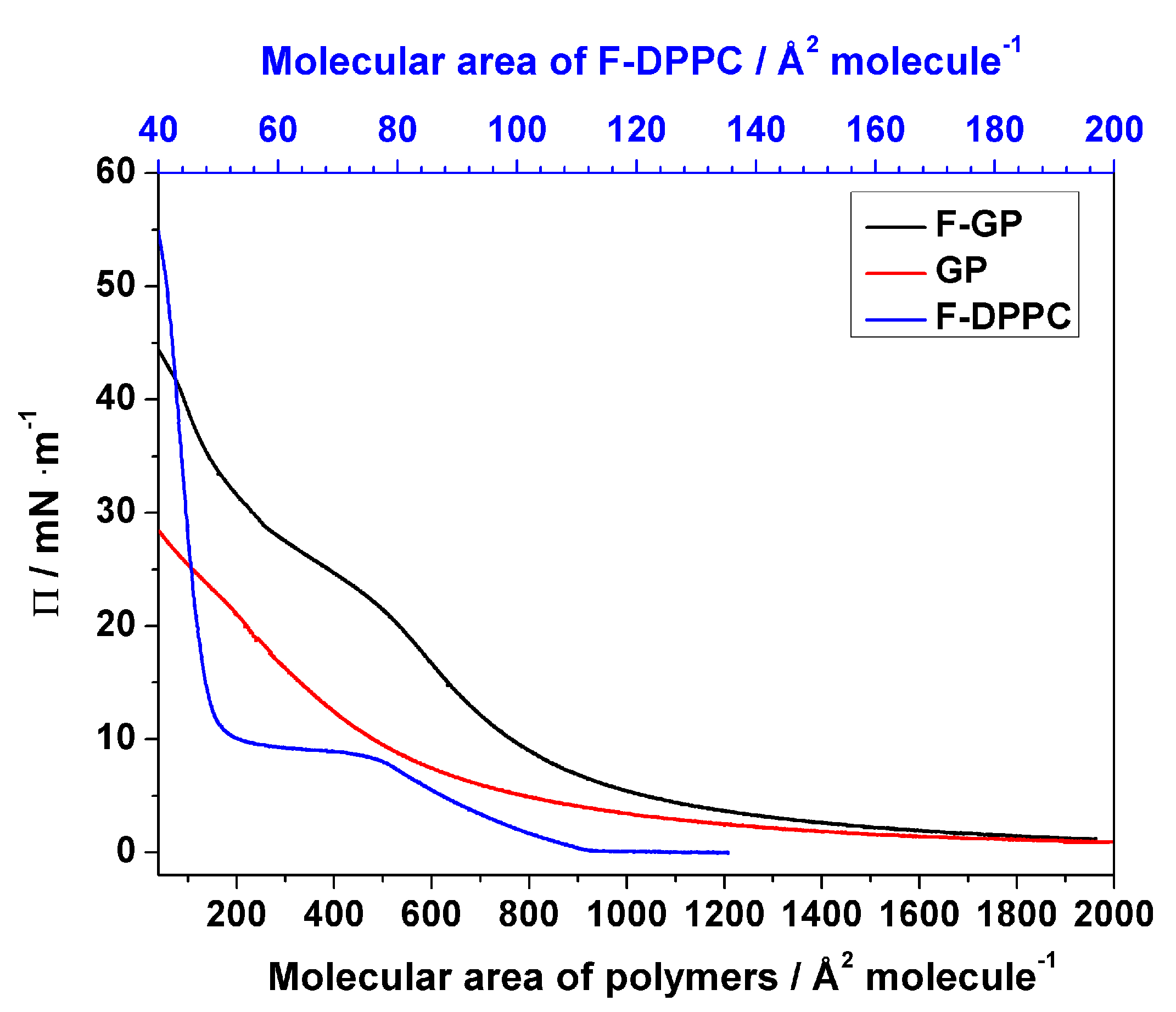
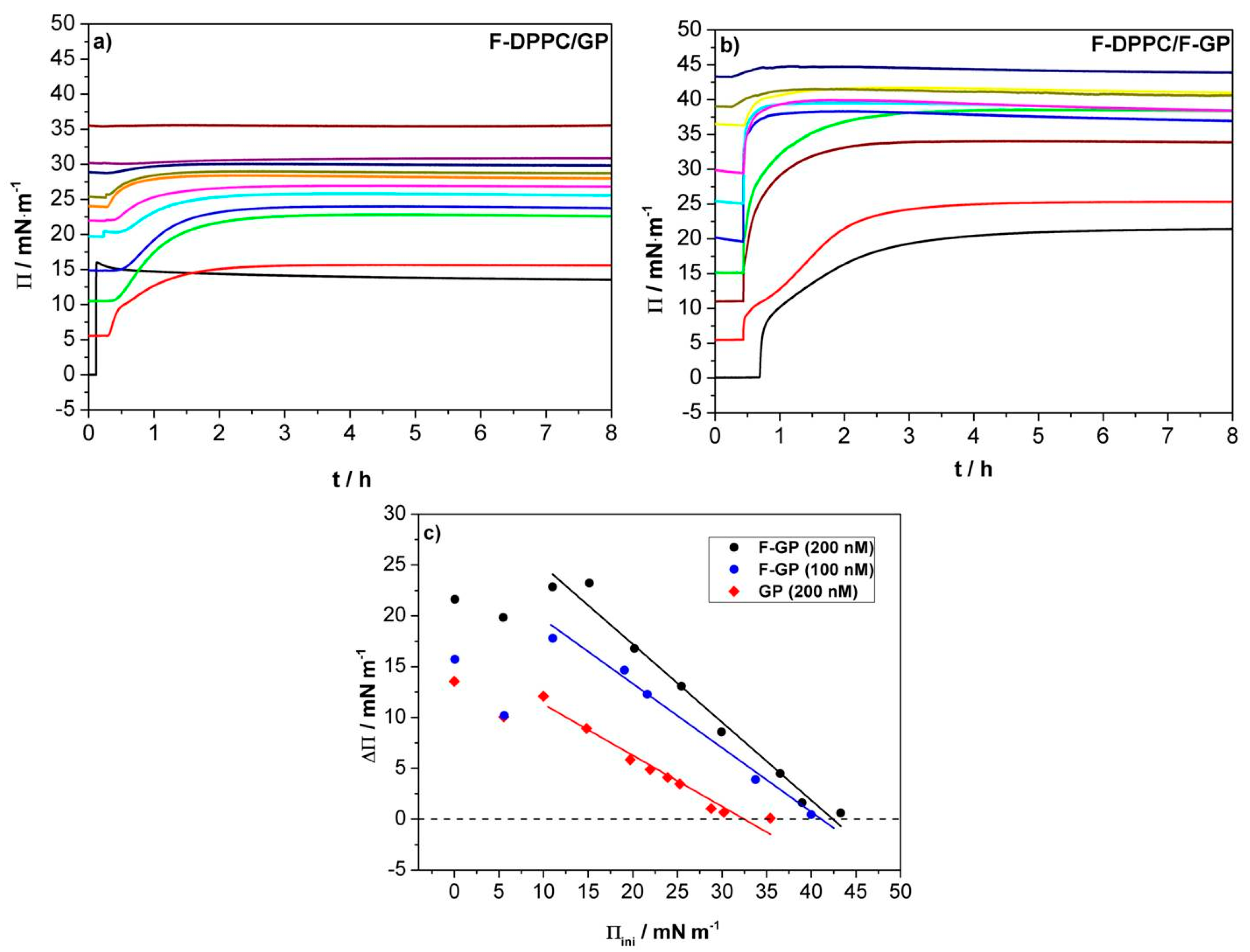
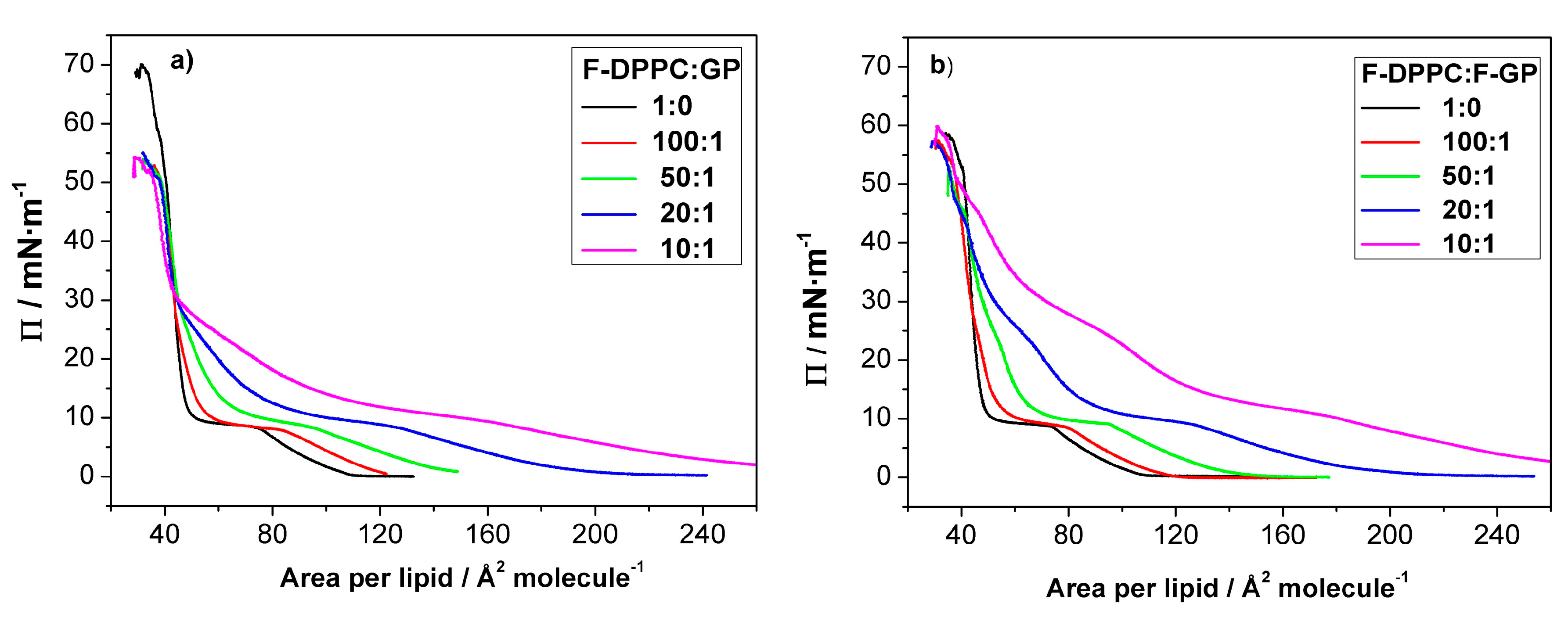
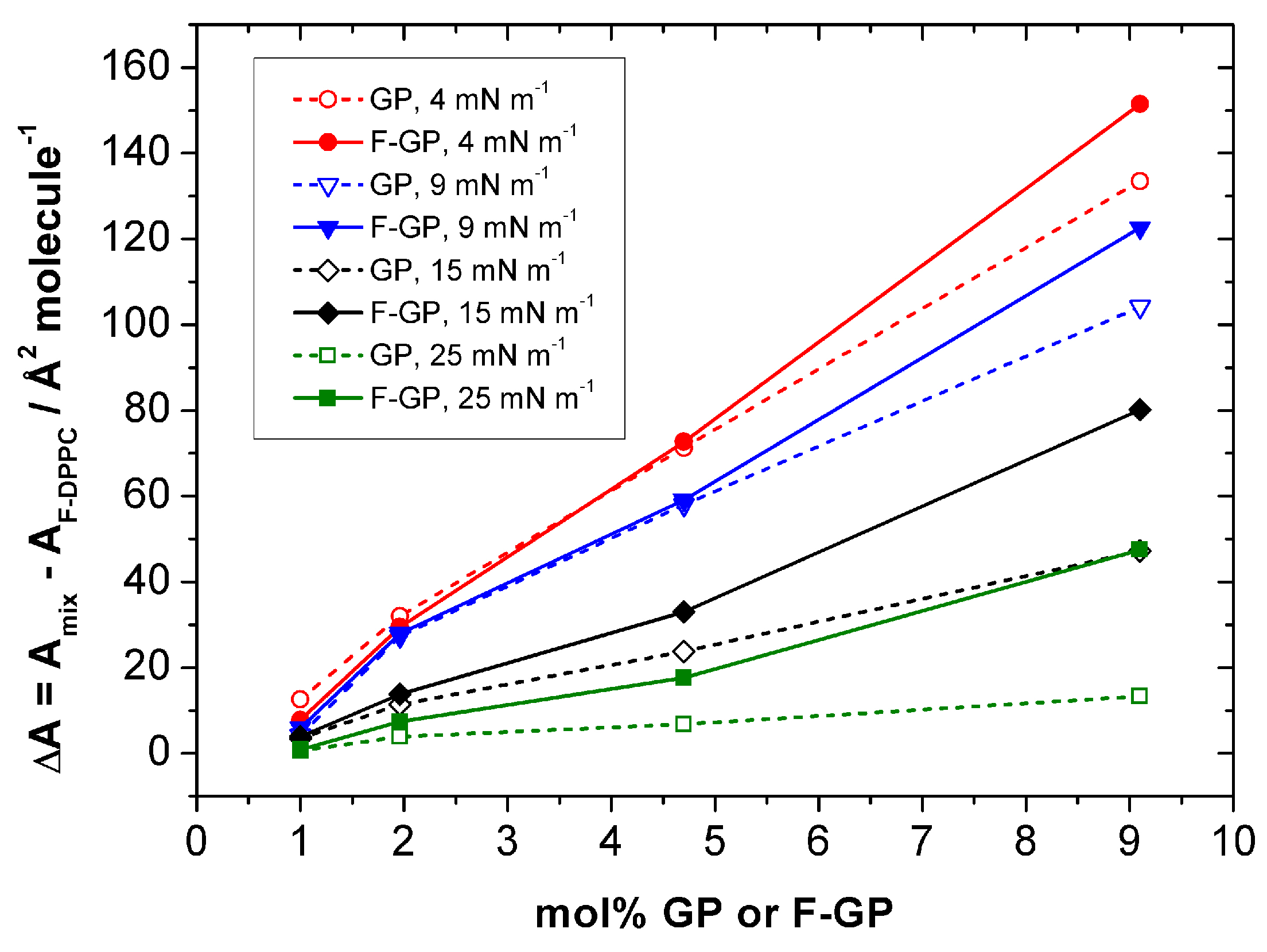
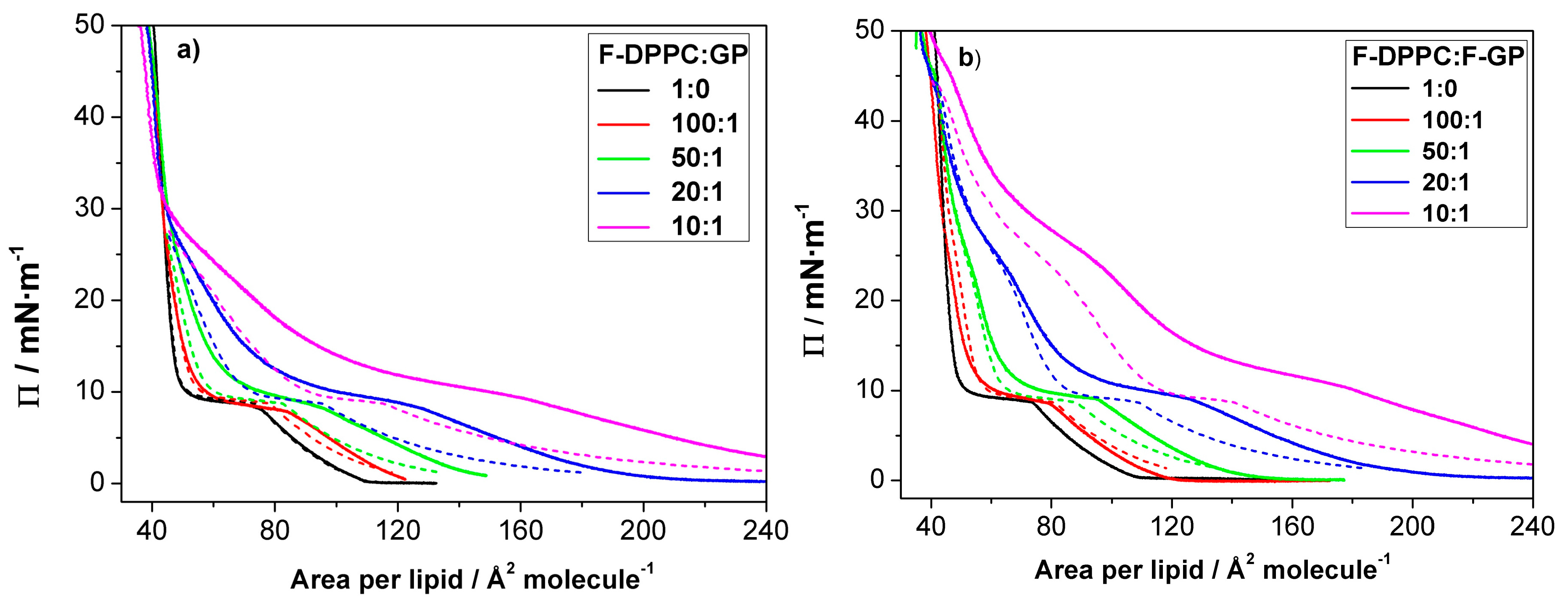
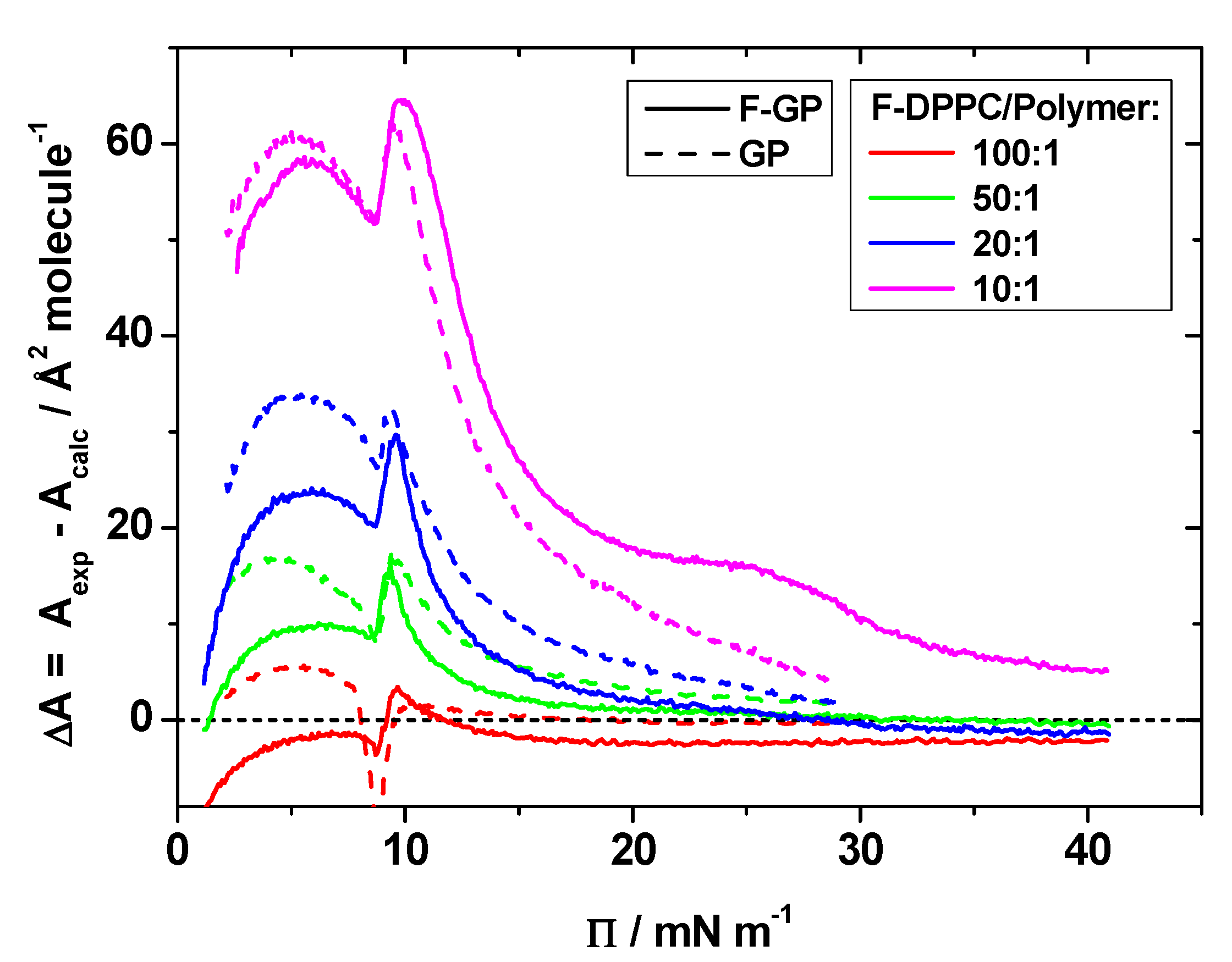
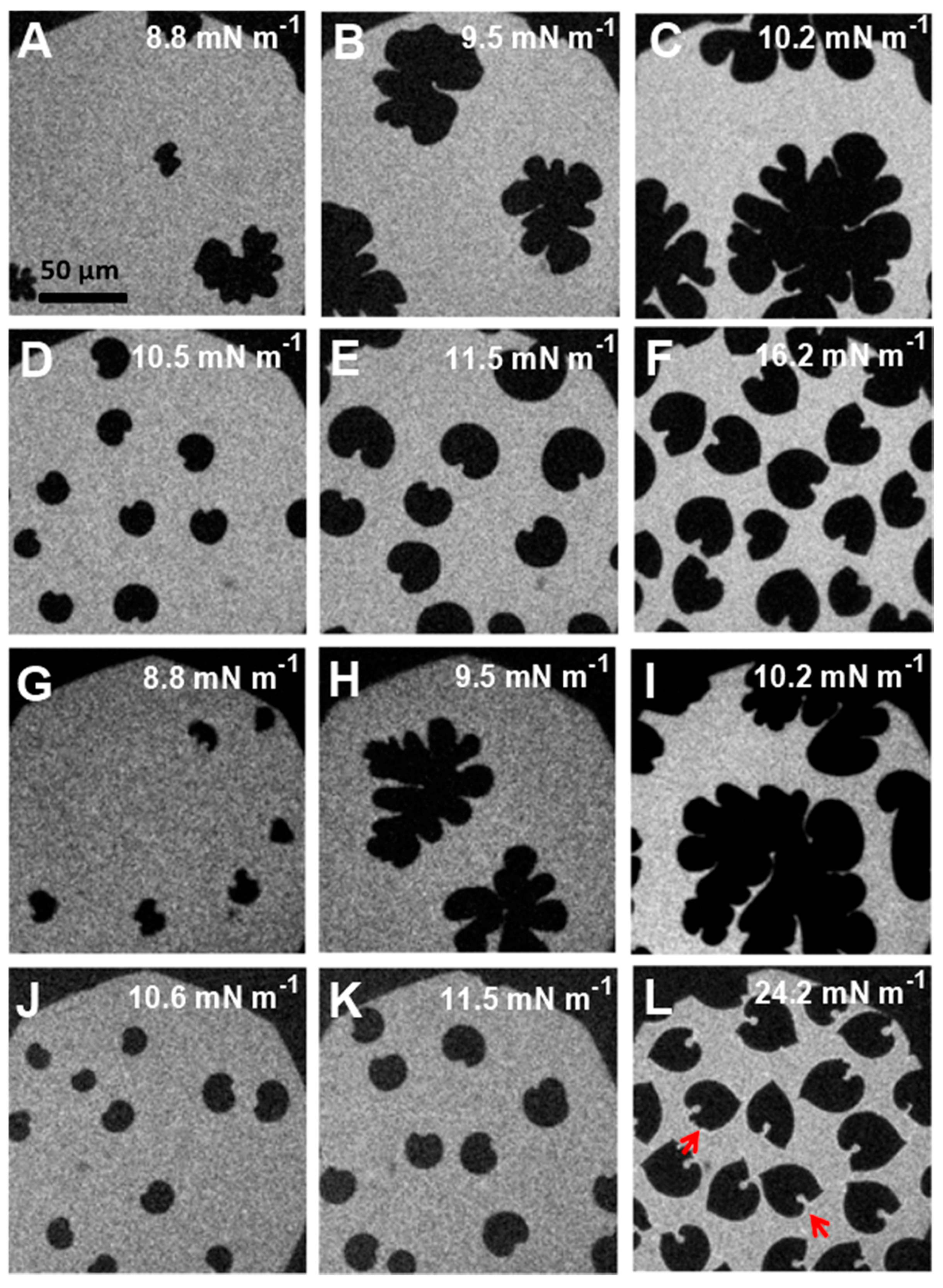
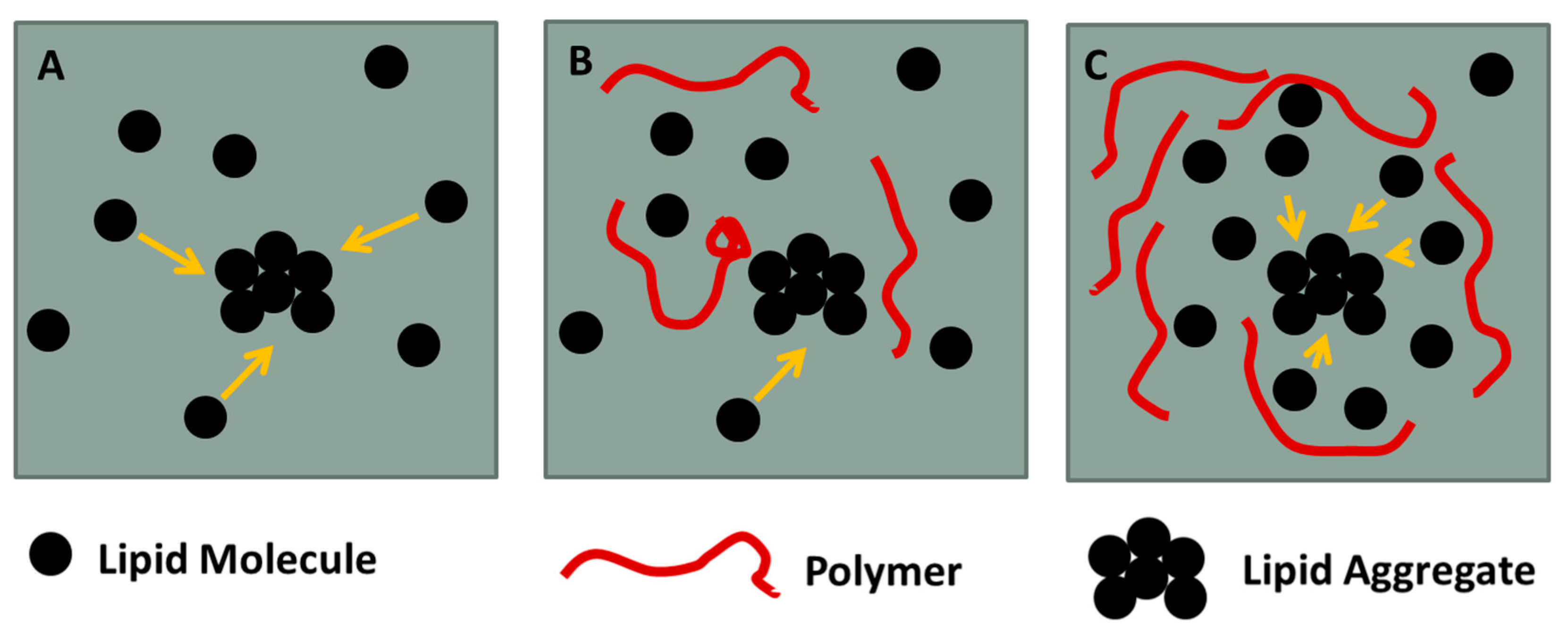
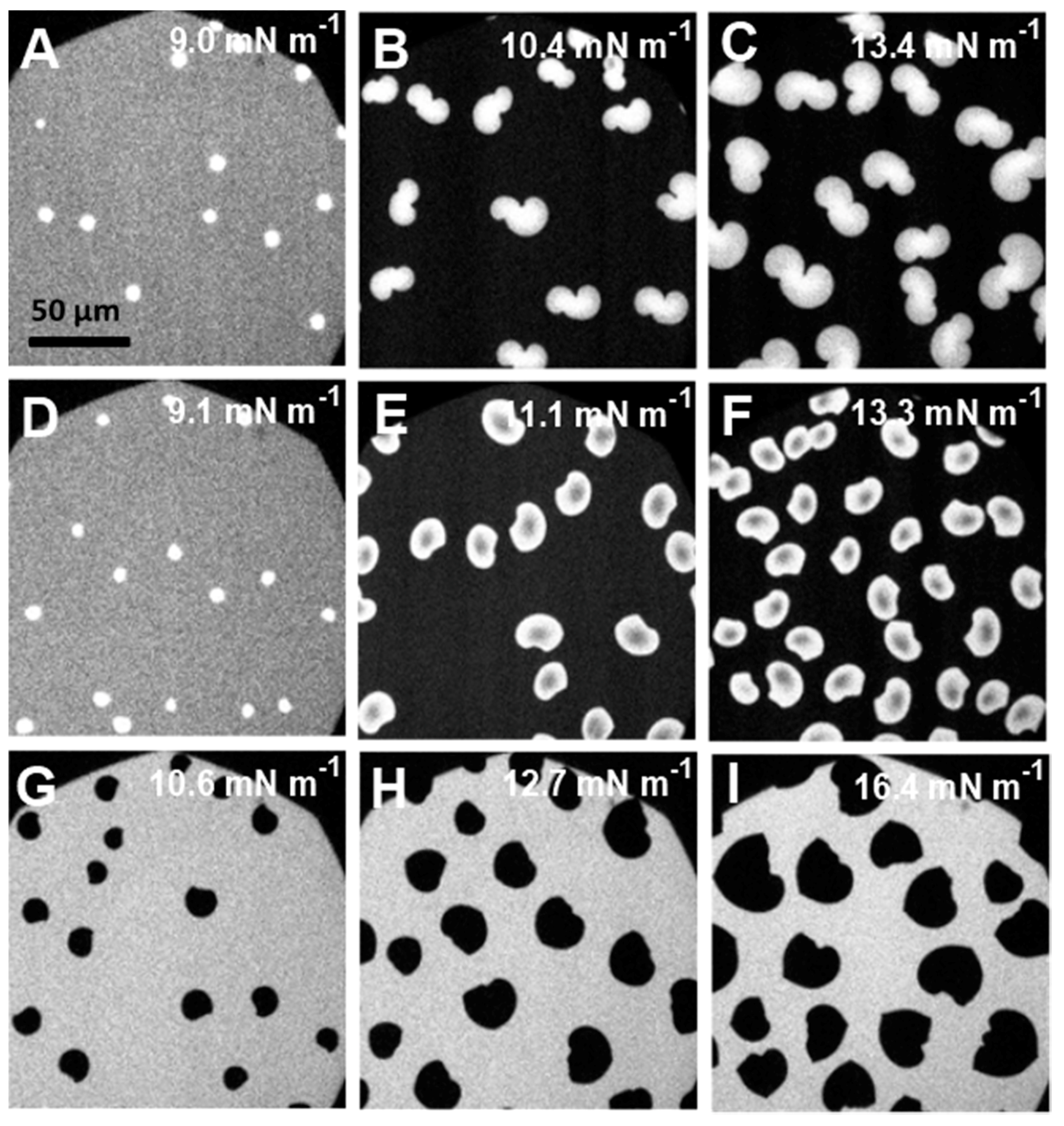
| Lipid/Polymer Ratio (Moles) | ΔA/Å2 Molecule−1 (F-DPPC) at Various Surface Pressures (Π) | |||||||
|---|---|---|---|---|---|---|---|---|
| 4 mN m−1 | 9 mN m−1 | 15 mN m−1 | 25 mN m−1 | |||||
| F-DPPC/GP | F-DPPC/F-GP | F-DPPC/GP | F-DPPC/F-GP | F-DPPC/GP | F-DPPC/F-GP | F-DPPC/GP | F-DPPC/F-GP | |
| 100:1 | 12.6 | 7.8 | 4.2 | 5.9 | 3.5 | 3.9 | 0.6 | 0.9 |
| 50:1 | 32.0 | 29.5 | 27.3 | 28.0 | 11.4 | 13.8 | 3.9 | 7.4 |
| 20:1 | 71.3 | 72.7 | 58.0 | 59.1 | 23.8 | 33.0 | 6.8 | 17.6 |
| 10:1 | 133.5 | 151.5 | 104.2 | 122.6 | 47.2 | 80.2 | 13.3 | 47.5 |
© 2017 by the authors. Licensee MDPI, Basel, Switzerland. This article is an open access article distributed under the terms and conditions of the Creative Commons Attribution (CC BY) license (http://creativecommons.org/licenses/by/4.0/).
Share and Cite
Shah, S.W.H.; Schwieger, C.; Li, Z.; Kressler, J.; Blume, A. Effect of Perfluoroalkyl Endgroups on the Interactions of Tri-Block Copolymers with Monofluorinated F-DPPC Monolayers. Polymers 2017, 9, 555. https://doi.org/10.3390/polym9110555
Shah SWH, Schwieger C, Li Z, Kressler J, Blume A. Effect of Perfluoroalkyl Endgroups on the Interactions of Tri-Block Copolymers with Monofluorinated F-DPPC Monolayers. Polymers. 2017; 9(11):555. https://doi.org/10.3390/polym9110555
Chicago/Turabian StyleShah, Syed W. H., Christian Schwieger, Zheng Li, Jörg Kressler, and Alfred Blume. 2017. "Effect of Perfluoroalkyl Endgroups on the Interactions of Tri-Block Copolymers with Monofluorinated F-DPPC Monolayers" Polymers 9, no. 11: 555. https://doi.org/10.3390/polym9110555
APA StyleShah, S. W. H., Schwieger, C., Li, Z., Kressler, J., & Blume, A. (2017). Effect of Perfluoroalkyl Endgroups on the Interactions of Tri-Block Copolymers with Monofluorinated F-DPPC Monolayers. Polymers, 9(11), 555. https://doi.org/10.3390/polym9110555





